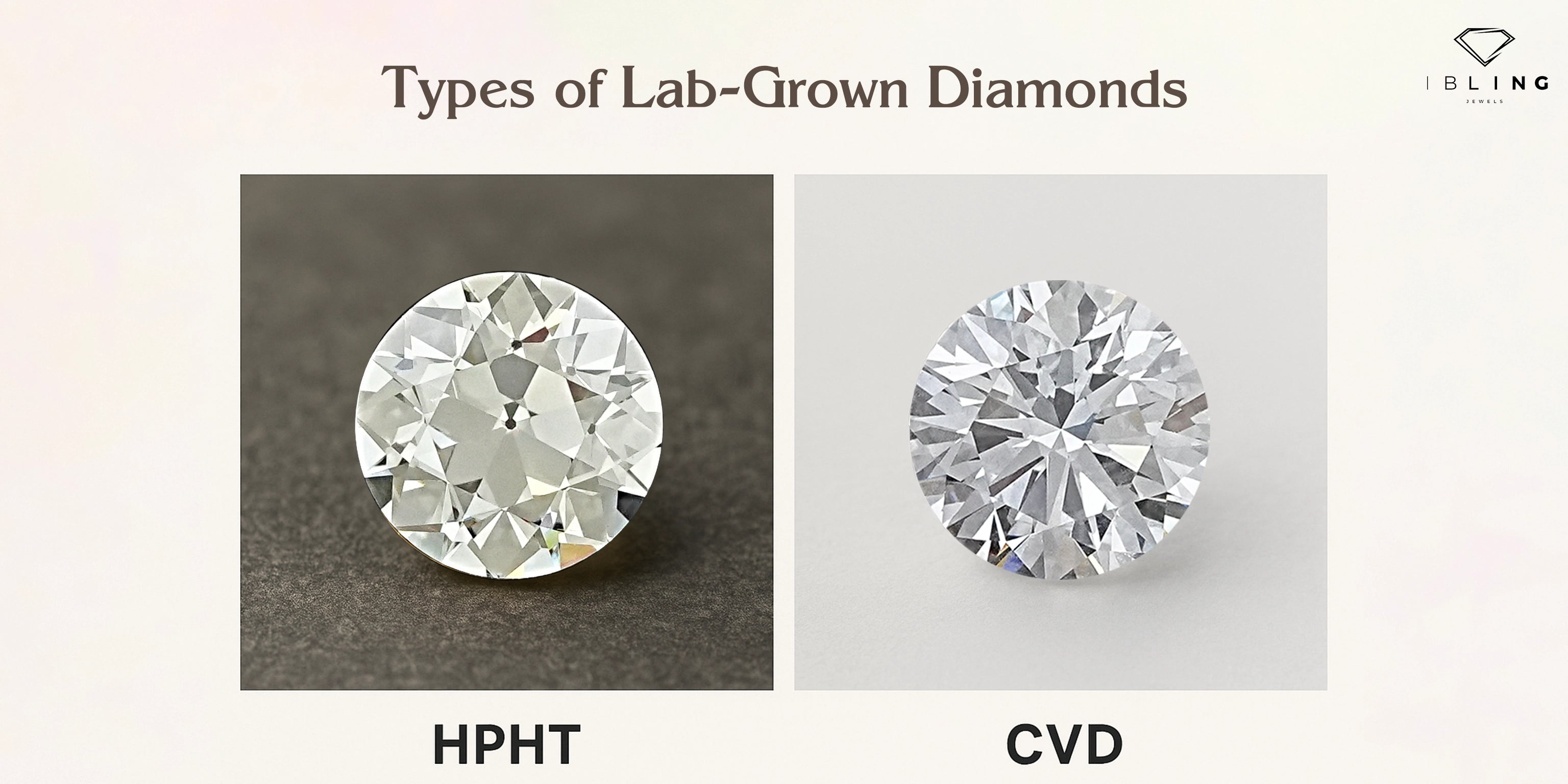
Natural VS Lab-Grown Diamond: An Extensive Comparison
Share

While diamonds have always held value, the technique used to form them has evolved. While natural diamonds were most desired, there has been a shift to lab-grown diamonds for their beauty and safety to the environment. What is the difference between lab grown diamonds vs natural diamond?
In this article, we will look at some of the main specifications, such as value, durability, ethics, among others, to enable you to find what best suits you. An individual searching for a ring or heirloom jewelry ought to take into consideration these variations.
Lab-grown jewelry from iBling Jewels is both beautiful and has a strong sense of ethical responsibility. We’ll see what makes every diamond different and how to find the right one...
Table of Contents
What is a Natural Diamond?
Over billions of years, a natural diamond grows deep within the Earth. This priceless diamond is the result of extreme heat and pressure. Rare and frequently seen as a status symbol, it is mined from the Earth. Many natural diamonds are significant in history and are given to new generations.
Due to their excellent brightness and origin, these diamonds are admired. But there is a cost to mining them. It expends a expansive amount of energy, overwhelming machinery, and manpower. The process can antagonistically influence communities and environments.
Natural diamonds are not left out in fine jewelry despite the effects. People admire them for their lasting beauty and unchanging charm. Natural diamonds are valuable gems and, at the same time, fragments of the earth’s history.
What Does a Lab-Grown Diamond Mean?

Lab-grown diamonds are genuine and not fake. Stones are made in a laboratory utilizing forms just like the ones that produce diamonds in Nature. The result? An artificial diamond that does the same job as a real Earth diamond but without harming the environment.
ibling Jewels provides plenty of lab-grown diamonds, including the classic round cut and the interesting Cushion Cut. Similar to natural diamonds, all lab-grown diamond pieces are certified by IGI as the best quality and bright.
Are Lab-grown Diamonds Real?
Diamonds synthesized in the laboratory are, yes, 100% genuine. They possess identical physical, Chemical, and optical properties as those of natural diamonds. The only difference is that it is mined on the planet, but the other one is manufactured in a laboratory in controlled circumstances.
The lab-grown diamonds are graded and certified by reputable bodies like the IGI (International Gemological Institute) and are graded in the same way as the natural ones. They have a ranking of 10 on the Mohs scale, implying that they are largely lustrous and hard.
Lab-grown diamonds have a genuine sparkle and last practically as long as natural diamonds, whether you are after an unique engagement ring or any custom item. They are environmentally friendly, ethical, and relatively cheap.
Types of Lab-Grown Diamonds

Lab-grown diamonds can be divided into two main types according to the circumstances according to which they are produced:
1. HPHT (High Pressure, High Temperature)
The process is simply an artificial recreation of how natural processes happen on Earth by exposing a carbon-bearing source to tremendous pressure and high temperatures. Most of its diamonds have a yellowish or brownish color, but many can be color-treated.
2. CVD (Chemical Vapor Deposition)
This is a newer process which produces diamonds by growing them in a gas rich in carbon in a vacuum. CVD diamonds are generally purer and have a whiter color, and they can be more controllable in shape and size.
Key Differences: Natural vs Lab-Grown Diamonds

These two types of diamonds are visually the same, but have very important differences.
-
Origin: Diamond mining is a naturally occurring one, but the lab-produced diamonds are created using certain procedures and components.
-
Price: The lab-grown diamonds are available at 30-40 percent cheaper than similar artificial diamonds.
- Rarity: Due to being such a rare item, diamonds can be seen as more valuable and suitable for the journey of investment.
Visual Appearance and Quality
With your naked eyes, can you easily identify whether a diamond is lab-grown or natural? Absolutely no. Both types rate a perfect 10 on the Mohs scale, and both twinkle and gleam with equal brightness.
The Ruby Tapered Baguette Halo Gemstone Engagement Ring from ibling Jewels shows how Fancy Colored Lab-Grown Diamonds are rare in the wild and much more affordable for anyone considering them. Olive green and blush pink are now easier to get and remain just as beautiful due to laboratory developments.
Ethical and Environmental Impact
Lab-grown diamonds address the problems people have with diamond mining. Traditional mining often destroys forests, leads to soil erosion, and causes problems with human rights in regions affected by conflicts.
Lab-grown diamonds end up with a much lower environmental impact. ibling Jewels strongly believes in buying from responsible sources. As lab-grown diamonds are conflict-free, buyers know they are getting peace of mind as well as a beautiful stone.
Whether you pick a Toi Moi or a Solitaire, both are gorgeous and also encourage sustainability.
Cost Comparison
Let’s talk about money. One of the biggest benefits of lab-grown diamonds is affordability.
For instance, at ibling Jewels:
-
A Pear Cut Lab Diamond Solitaire Accent Ring may cost around $200, while a similar natural diamond would easily exceed $1,000.
- A Ruby Tapered Baguette Halo Gemstone Engagement Ring in a lab-grown version runs around $555—luxury at an accessible price.
This price gap gives buyers freedom to upgrade in size, cut, or setting without stretching their budget. Instead of buying a single natural stone, you can buy a bigger carat, a more elaborate design, or find earrings that match your ring (such as the Tiny Round Cut Lab Diamond Floral Shape Stud Earrings) at the same price.
Popularity and Trend Shift
The millennials and Gen Z consumers are highly educated in our current times and take ethics seriously. They want to know about the origin of their diamonds. This is leading to the emergence of cultured diamonds.
The reasons why lab-grown diamonds are in fashion:
-
Ethical sourcing: Guarantee that there is no mining and therefore no human exploitation or harm to nature.
-
Affordability: A better value for the price is something practical luxury fans look for.
-
Celebrity approval: Many celebrities show off lab-grown diamond rings in public.
- Social values: Purchasing lab diamonds shows you care about the environment and modern norms in relationships.
ibling Jewels plays a central role in this trend. The Round Cut Lab Diamond Bezel Set Tennis Bracelet and Emerald and Baguette Lab Diamond Five Stone Ring are made ethically and show timeless beauty.
They are not only accessories; they express both style and purpose.
Craftsmanship and Certification
Skilled labor is required in both types of diamonds. A stone could be naturally produced as well as manufactured in a laboratory, but the difference will be brought in the way of cutting and placement of the stone and its design.
All the lab-grown diamonds used by All the ibling Jewels have been certified by IGI, unlike all the natural ones. Thus, there may be an anticipation of the same cut, clarity, and color. When you have collections like Round Cut Solitaire Bezel Set Stud Earrings and Princess Cut Lab Diamond Bridal Ring Set, you get both originality and skill.
When to Choose Natural vs Lab-Grown
It is a matter of what is important to you and whether to use a natural or lab-grown diamond. Both have their merits, and it will depend on your beliefs, your pocket, and your lifestyle.
Choose Natural Diamonds If:
- You value tradition and the historical legacy of earth-mined stones.
- High on the priority list is its long-term resale value and rarity.
- You would desire to have a stone that is not in the box, one that would have a stone with a history behind it.
Choose Lab-Grown Diamonds If:
- You desire a diamond that actually looks fantastic and is ethically sourced at cheaper rates.
- Attempting to take into consideration the sustainability of your purchasing choices.
- You enjoy unusual designs and color choices and would not mind paying a decent price as well.
As an example, in case you want an antique-inspired ring with ethically selected minerals, the Radiant Lab Diamond Hidden Halo Solitaire Accent Ring created by ibling Jewels will serve you well. The jewelry retains the classic charm that can never be dated, given that it is certified by the IGI and also assured of ethical raw materials.
Conclusion
Both lab grown and natural diamonds have distinguished names for being very attractive and durable. The preference of the school is based on what is important to you and preferable to you.
Laboratory diamonds give off the same brilliant sparkle at a lower price and with less responsibility. People who appreciate the old style tend to use natural diamonds.
📌FAQs
No, you cannot tell just by looking. Both lab-grown and natural diamonds cannot be told apart without professional equipment. Experts rely on advanced gemological tools.
Absolutely. Lab-grown and natural diamonds have the same toughness and rank 10 on the Mohs scale. They are safe for daily wear and maintain their brilliance with proper care.
Yes. Lab-grown diamonds often cost 30–40% less because they are created without mining. This makes them a great option for budget-conscious and eco-conscious buyers.
Lab-grown diamonds generally have lower resale value than natural ones. However, their ethical appeal and affordability make them popular for personal wear, not investment.
Yes. Reputable jewelers like iBling Jewels provide certification from trusted labs like IGI, confirming the quality and authenticity of your lab-grown diamond.
Lab-grown diamonds are often seen as more ethical. They avoid mining, reduce environmental impact, and promote responsible sourcing when purchased from brands like iBling Jewels.
Yes! iBling Jewels offers fully customizable lab-grown rings, including unique shapes like butterflies or custom eternity designs. You can choose your preferred style, metal, and color.
Yes! Lab-grown diamonds are ideal for engagement rings. They’re stunning, affordable, and represent a sustainable, modern approach to love and commitment.
Absolutely. Lab-grown diamonds can be created in vibrant shades like pink, blue, and green colors that are rare in nature but more accessible and affordable in lab form.

